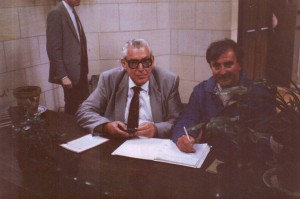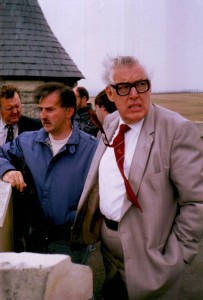Ulster Tower, Thiepval
On Friday 12th September,1986, I first brought my friend Dr Ian Paisley, MP, MEP, accompanied by Nigel Dodds, Fred Proctor and Jackie Hewitt to the Somme Battlefield, where they visited the Ulster Tower at Thiepval, the trench system at the Memorial Park Beaumont-Hamel and the Thiepval Monument. Dr Paisley confirmed he would arrange a meeting with the Commonwealth War Graves Commission about re-opening the Ulster Tower Museum and the provision of oral documentation and photographic displays which Farset Youth and Community Development would help to provide.
Signing the Visitor’s book at the Ulster Tower.
Looking towards Thiepval Wood from the Top of the Tower
The Ulster Memorial Tower stands on what was the German front line during the Battle of the Somme, July to November 1916. It is opposite Thiepval Wood from where the 36th (Ulster) Division made its historic charge on the 1st July 1916 and is in close proximity to the village of Thiepval.
The Tower stands 70 feet tall and is a lasting tribute to the men of Ulster who gave their lives during the First World War. Its position on the battlefield is a permanent reminder of the 36th (Ulster) Division’s heroic charge at the Battle of the Somme on the opening day of that great offensive.
The Ulster Memorial Tower was the first official memorial to be erected on the Western Front and was dedicated on 19th November 1921. The Tower itself is a replica of a well known Ulster landmark, Helen’s Tower, which stands on the Dufferin and Ava Estate at Clandeboye, above Conlig, County Down.
Helen’s Tower, Conlig
Clandeboye Camp with Helen’s Tower in the distance
When demands grew for the construction of a publicly-funded battlefield memorial at Thiepval in honour of Ulster’s fallen, Sir James Craig proposed, at a meeting held in Belfast’s Old Town Hall on 17th November 1919, that the monument should take the form of a prominent Ulster landmark. The proposal struck a chord and Helen’s Tower seemed the ideal choice, standing as it did in view of the Clandeboye training camp of the 36th (Ulster Division)
On Saturday 19th November 1921 the completed Tower was opened by Field Marshal Sir Henry Wilson, Chief of the Imperial General Staff, later assassinated by the I.R.A. The principal room inside the Tower is a sixteen feet square memorial chamber, faced throughout in stone, with an inscription tablet in marble. The inscription reads:
This Tower is dedicated to the Glory of God, in grateful memory of the Officers, Non-Commissioned Officers and Men of the 36th (Ulster) Division and of the Sons of Ulster in other Forces who laid down their lives in the Great War, and of all their Comrades-in-Arms, who, by Divine Grace, were spared to testify to their glorious deeds.
The upper portion of the Memorial Tower provides accommodation for a caretaker. By the late 1980s however the Tower had fallen into disrepair and public access was limited.

